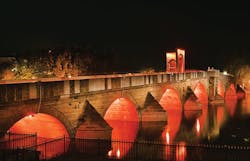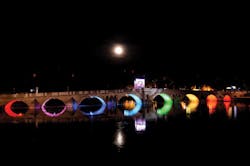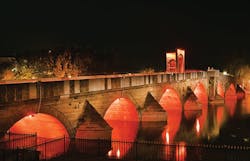The combination of functional white lighting and layered color accent lighting in the Tunca Bridge project deliver driver and pedestrian safety - and a pleasing experience for observers - while matching the relatively low light levels in the area, reports MAURY WRIGHT.
A new LED-based bridge lighting project in Turkey relies on a layered approach to deliver both functional and façade lighting that reveals the historic and subtle architectural features of the iconic structure and at times can deliver dynamic color presentations. Philips Lighting announced the lighting of the Tunca Bridge that was built during the time of the Ottoman Empire and that provides a vital link crossing the Tunca River between Edirne, Turkey, western neighborhoods of the city, and ultimately Greece (Fig. 1). Solid-state lighting (SSL) products, including color-tunable LED fixtures from Philips Color Kinetics, combine with a network control system to present a dynamic nighttime experience that also matches the ambience of the local area (Fig. 2).
The lighting plan included providing functional illumination of the bridge for pedestrians and vehicles and also a pleasing nighttime visual experience for observers. A base layer of white light provides general visibility requirements. The accent or architectural lighting provides the visual experience and includes tunable color.
The design of the general illumination elements includes pole-mounted luminaires located at four spots on the banks of the river. In addition, fixtures mounted on the parapet walls of the bridge, and hidden from view, provide pools of light rather than a uniform, homogenous pattern. The design was accomplished in a manner that will not cause glare to drivers or pedestrians or to anyone in the surrounding area.
Indeed, the project plan noted that the bridge is located on the outskirts of the city and in an area with relatively low light levels. The planners intended to minimize light spill and match the general light levels from the new project to the levels in the general area of the bridge (Fig. 3).
FIG. 1. The Tunca Bridge in Turkey, which was built during the Ottoman Empire, is the site of Philips' latest architectural lighting triumph.
The bridge structure includes 11 piers and 12 vault-shaped arches or spans that allow water to pass. Spandrel walls abut the spans. The architectural lighting is intended to provide low levels of light on the spandrel walls with the majority of the lighting on the lower structure meant to fill the space in the architectural spans. Moreover, the design also includes inner and outer lighting of the dome of the Kitabe Pavilion in the center of the bridge. Color or shades of white can be applied to both the arches and the central tower.
Philips has been involved with a number of bridge projects, including the Big Four Bridge in Louisville, KY. But the Tunca project required great care to ensure that no damage was done to the bridge structure and stone. Indeed, the company said it had to devise ways to mount the LED fixtures without drilling into the bridge structure.
Instead, the team working on the bridge used a combination of friction and tension to hold steel plates in place to which luminaires could be mounted. Steel cables were wrapped around certain structural elements of the bridge and those cables were tightened to secure the plates. The team also installed protective plates to ensure that the tensioned cable did no damage to the texture of the stone around the luminaire mounting plates.
The project also had to take into account that sporadic flooding would significantly raise the water level in the spans and in cases even rise to the parapet walls. So the lighting on the lower portions of the bridge had to be rated for operation in a wet environment.
FIG. 2. Color-tunable architectural lighting fixtures from Philips Color Kinetics are programmable for dynamic nighttime illumination.
The completed project uses Color Kinetics iColor Graze MX Powercore linear grazing luminaires, Color Blast Powercore wall washers, and water-resistant C-Splash LED fixtures to deliver the dynamic or subtle lighting of the arches. The project also used Philips ProFlood 150W projectors and ilti Luce Lux20 spotlights from a Philips business unit in Italy.
Previously, simple projectors only lit the silhouette of the bridge. The new system fully reveals the arches and façades of the structure. In addition to the far superior lighting experience afforded by the new SSL installation, the project will deliver significant energy savings of 53% relative to the simpler projector-only systems used previously. Moreover, a combined wired and wireless control system allows for both the dynamic presentation and dimming of the lighting for additional savings.
The finished project has fulfilled the goals of an installation that reveals the historical structure while adding a modern touch. The color lighting can be matched to the natural colors of the stone, thus making the effect subtle. But the project was intended to allow visitors to experience the dynamic capabilities at other times and even hint at the transportation function that the bridge enables. Moreover, the span lighting and that on the central kiosk are harmonized, providing a sense of the visual elements being unified.
Philips worked directly with the Governor's Office of Edirne on the project. "The preservation of historical monuments that are cultural assets should not be seen as the responsibility of conservation specialists alone," said Özge Süzen, marketing director for Philips Lighting in Turkey. "At Philips, we believe that we can add a far wider dimension to the concept of preservation by infusing life into monuments with light and drawing on the contribution of townspeople. We would like to thank the Office of the Governor of Edirne for their support in managing the process and their appreciation of the role of light to help preserve and enhance our cultural heritage."
FIG 3. The architectural lighting project was designed to minimize light spill while providing functional pedestrian illumination that also matched the ambience of the bridge area to maintain its historic appearance.
Indeed, historic sites present special challenges to lighting designers and specifiers. LED-based products with lower power requirements, better beam control, and greater lumen output have been vital in many such projects. For example, we have previously covered the lighting of the Recouvrance lift bridge in Brest, France. Recently, we wrote about the new LED lighting of the historic Citadel of Bonifacio on Corsica. A more modern installation we have just reported highlights the updating of an art-deco icon of the New York skyline.








